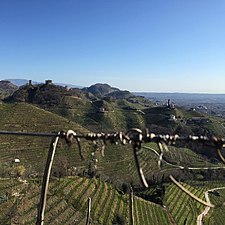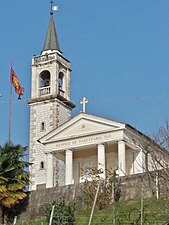| Valdobbiadene Valdobiàden (Venetian) | |
|---|---|
| Comune | |
| Comune di Valdobbiadene | |
 Valdobbiadene Valdobbiadene | |
| Location of Valdobbiadene | |
  | |
| Coordinates: 45°54′N 11°55′E / 45.900°N 11.917°E / 45.900; 11.917 | |
| Country | Italy |
| Region | Veneto |
| Province | Treviso (TV) |
| Frazioni | Bigolino, Guia, San Giovanni, San Pietro di Barbozza, Santo Stefano, San Vito Località: Follo, Funer, Guietta, Pianezze, Ron, Saccol, San Giovanni, Soprapiana, Villanova, Zecchei |
| Government | |
| • Mayor | Luciano Fregonese |
| Area | |
| • Total | 60.70 km (23.44 sq mi) |
| Elevation | 247 m (810 ft) |
| Population | |
| • Total | 10,388 |
| • Density | 170/km (440/sq mi) |
| Demonym | Valdobbiadenesi |
| Time zone | UTC+1 (CET) |
| • Summer (DST) | UTC+2 (CEST) |
| Postal code | 31049 |
| Dialing code | 0423 |
| Patron saint | St. Gregory the Great |
| Saint day | Second Monday in March |
| Website | Official website |
| UNESCO World Heritage Site | |
| Official name | Le Colline del Prosecco di Conegliano e Valdobbiadene |
| Criteria | Cultural: (v) |
| Designated | 2019 (43rd session) |
| Reference no. | 1571 |
| Region | Southern Europe |
Valdobbiadene (Italian: [ˌvaldobˈbjaːdene]; Venetian: Valdobiàden) is a town and comune (municipality) in the province of Treviso, Veneto, Italy. Valdobbiadene is a wine growing area: located below the Alpine-Dolomite areas of Veneto, the climate allows the cultivation of the Glera variety of grape.
The Conegliano Valdobbiadene area is the home of the best Prosecco, an extra dry sparkling white wine. Prosecco brands that derive from this area include Altaneve, Bisol, Mionetto, Col Vetoraz, Coda, Valdo and others.
On 7 July 2019, Le Colline del Prosecco di Conegliano e Valdobbiadene was inscribed as a UNESCO World Heritage Site.
History
The territory was subjected to Treviso until 1178, after which it was occupied by the Ezzelini family until 1260, when it returned under the jurisdiction of Treviso. Constantly plagued by battles and depredations, around the middle of the 14th century it fell under Venetian domination: this put an end to feudalism and, while respecting the political power of the Serenissima, Valdobbiadene was divided into its fifteen rural communities (so-called "Rules"), obtains a semblance of autonomy with the self-government of the Merighi, men democratically elected among the heads of the family. With the arrival of Napoleon and then, with the Austrian domination, the Regole disappeared and the Municipalities arose, first three, then two: Valdobbiadene, San Pietro di Barbozza and Bigolino, which survived only a few years (later also San Pietro di Barbozza will be incorporated into the Municipality of Valdobbiadene).
Monuments and places of interest
Religious architecture
- Cathedral of Santa Maria Assunta
- The church of San Giacomo Apostolo in Guia
- Church of San Giacomo Apostolo, parish church of Guia (attributed to Canova)
- Church of San Giovanni Battista, parish church of San Giovanni, built between 1924 and 1925.
- Church of Saints Vito, Modesto and Crescenzia in the hamlet of San Vito
- Church of Saints Rocco and Sebastiano (Martignago), dating back to 1855
- Church of Santa Maria Assunta (Follo), built between 1866 and 1867 and consecrated on 24 May of that same year.
- Church of San Gregorio Magno (Colderove), built in the 16th century and consecrated in 1603.
- Parish Church of Santo Stefano Protomartire (Saint Stephen)
- Church of San Michele Arcangelo (parish church of Bigolino)
- Parish church of San Pietro di Barbozza
- Church of Sant'Alberto (San Pietro di Barbozza)
- Church of Saints Rocco and Bernardino di Ron
- Church of the Precious Blood in Pianezze (20th century)
- Small church of Sant'Agata, in the Funer area
- The Sanctuary of the Madonna di Caravaggio in Funer
- Church of Santa Margherita di Villanova
- Church of San Martino
- Church of the Madonna of Lourdes in Ponteggio
- Oratory of Santa Maria Assunta, Follo area
- Oratory of Santa Lucia and Santa Fede (Martignago)
- Oratory of Saint Anthony of Padua (Guietta)
- Sanctuary of the Madonna of Caravaggio, in the Funer area
- Church of San Floriano, in via San Floriano.
Civil architecture
Venetian villas

- Villa Barberina Arten Viansson
- Villa Barbon Bennicelli, in the hamlet of San Vito
- Villa Morona De Gastaldis
- Villa dei Cedri, formerly Villa Piva, it lies in the center of Valdobbiadene, within a landscape declared a UNESCO World Heritage Site, in which the work of the winemakers, combined with the nature of the place, has contributed to creating a unique scenario. in the municipality.
Natural areas
Monumental trees
In the municipal territory there are 6 monumental trees of the 16 located in the province of Treviso and included in the list of approximately 22,000 trees protected by the forest guard.
Demographic evolution

Foreign ethnicities and minorities
As of December 31, 2022, foreign residents in the municipality were 1,045, i.e. 10.5% of the population. The largest groups are shown below:
- North Macedonia 214
- Morocco 179
- China 145
- Romania 144
- Albania 89
- Ukraine 70
- Moldova 48
- Brazil 38
- India 27
- Bosnia and Herzegovina 11
Culture
Instruction

In the municipality there are pre-school, primary and lower secondary schools. The secondary school of some importance for the city is the "G. Verdi" Higher Education Institute (I.S.I.S.S.), which hosts the following courses: high school, technical and professional.
It was founded as an autonomous state institute in 1999, aggregating the different courses of study present in the area into a single Higher Secondary Education Institute. In the curriculum design phase, the Verdi Institute took into account both the existing directions and the training and professional needs that the territory expressed.
Economy
The nascent bourgeoisie in the 19th century made up of merchants, notaries, landowners who acquired the lands of the Venetian nobility and who held political power in their hands, embellished the square with palaces. The silk industry develops, thanks to the Piva family. During World War I the territory was the target of heavy bombing and was evacuated. With the return and reconstruction, wine cultivation developed.
Valdobbiadene, nearby Conegliano and their hills are considered the cities of the Prosecco di Conegliano-Valdobbiadene wine and, in particular, of the Superiore di Cartizze type and also included in the Città del Vino circuit and has been the home of the National Sparkling Wine Exhibition, now the Sparkling Wine Forum of Italy, for over forty years.
Infrastructure and transport
Between 1913 and 1931 Valdobbiadene represented the northern terminus of the Montebelluna-Valdobbiadene Tramway, which at the time represented an important development tool for the economy of the area.
The town is served nearby by the Alano-Fener-Valdobbiadene station on the Calalzo-Padova railway, connected directly by the MOM with bus line n.126, while the center of Valdobbiadene is connected to Treviso by the MOM bus line n.110: Treviso, Postioma, Montebelluna, Valdobbiadene.
Prosecco Hills Link is the new intermodal solution born from the synergy between Trenitalia and MOM-Mobilità di Marca. You will be able to arrive in Conegliano by train and comfortably reach by bus the Prosecco Hills of Conegliano and Valdobbiadene, a privileged destination for food and wine and nature tourism, now known to the international public and a place declared a World Heritage Site by UNESCO world of humanity.
Gallery
-
 Towards Mount Cesen
Towards Mount Cesen
-
 Prosecco Valley
Prosecco Valley
-
 Prosecco San Vito
Prosecco San Vito
-
 Ponteggio - little church of Our Lady of Lourdes
Ponteggio - little church of Our Lady of Lourdes
Twin towns
Valdobbiadene is twinned with:
 Mór, Hungary
Mór, Hungary
References
- "Superficie di Comuni Province e Regioni italiane al 9 ottobre 2011". Italian National Institute of Statistics. Retrieved 16 March 2019.
- All demographics and other statistics from the Italian statistical institute (Istat)
- Negron, Isaiah. Resident Magazine. Luxury Italian Prosecco Vintner David Noto. January 1, 2014. Archived November 7, 2014, at the Wayback Machine
- "Two cultural sites added to UNESCO's World Heritage List". UNESCO. 7 July 2019.
- storia-comune comune.valdobbiadene.tv.it
- "Villa Barberina Arten Viansson". culturaveneto.it. Retrieved 31 October 2021..
- "Villa Piva, detta "dei Cedri"". culturaveneto.it. Retrieved 31 October 2021.
- Cfr. il censimento nazionale degli alberi monumentali Archived 26 June 2014 at the Wayback Machine
- ISTAT (ed.). "Demographic balance and foreign resident population at 31 December 2022 by gender and citizenship". Retrieved 31 July 2023.
- "la nostra storia". isissverdi.it (in Italian). Retrieved 31 October 2023.
- Alano-Fener-Valdobbiadene rfi.it
- Routes-and-timetables suburban-service mobilitadimarca.it
- FS news, ed. (23 June 2023). "Arriva il Prosecco Hills Link: treno+bus per un turismo sostenibile" (in Italian).
External links
- Le Colline del Prosecco di Conegliano e Valdobbiadene UNESCO Collection on Google Arts and Culture